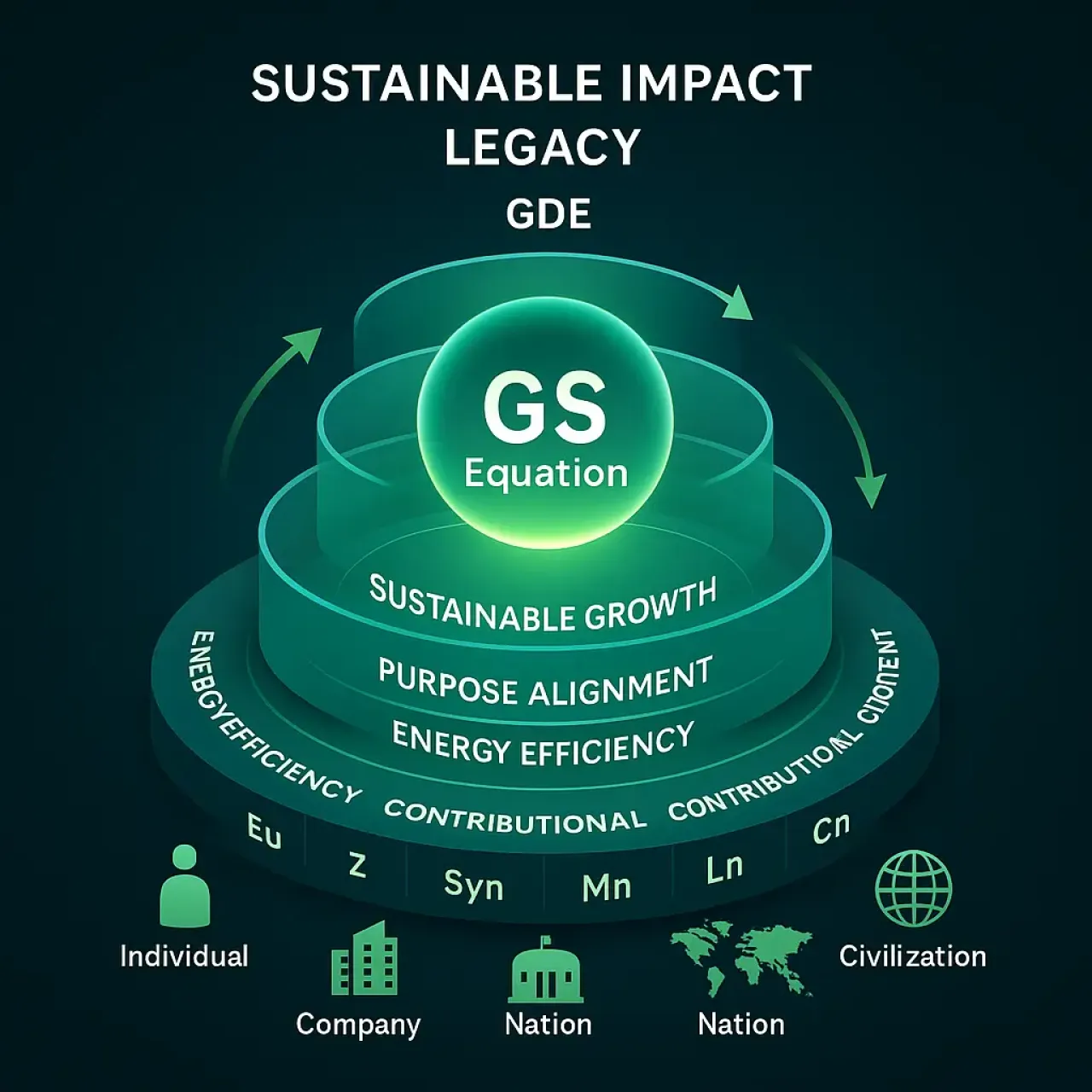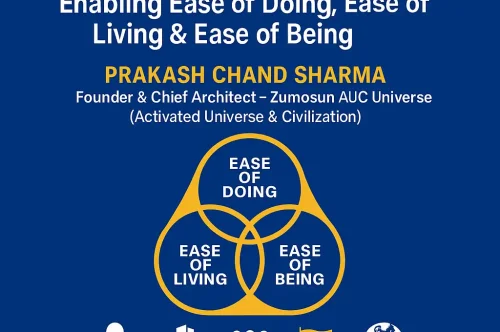Understand How the GS Equation Creates Sustainable Impact – Zumosun AUC Framework

Understand How the GS Equation Creates Sustainable Impact
Introduction
The world is at a crossroads. Traditional measures of success—profit, GDP, or short-term growth—no longer capture the true sustainability and impact of human actions. Climate change, inequality, and systemic fragility reveal the flaws of fragmented progress.
To solve this, the Zumosun Activated Universe & Civilization (AUC) introduces the GS Equation (Growth & Success Equation)—a transformative framework developed by Prakash Chand Sharma. It redefines growth, success, and sustainability not as isolated outcomes but as activated contributions aligned with the PURE Equation and Zuositivity.
The GS Equation is the mathematical and philosophical foundation for creating lasting civilizational impact.
What is the GS Equation?
The Growth & Success (GS) Equation, developed within the Zumosun Activated Universe & Civilization (AUC) by Prakash Chand Sharma, offers a comprehensive, multidimensional formula that aligns energy, strategy, values, innovation, and efficiency into one activated model.
It is not just a mathematical representation—it is a civilizational success compass that ensures growth leads to sustainable impact.
[Growth & Success (GS) Equation=[{FDI-U)*(SKIWEEE)T*T- R.W (PCCR) of PFS-W.W (8W5H) 5-I.W (RII)+ (H2ODPC)+ (SMART) + (KPA + KPI +KRI) +(IMKIA) + (SWOT) + A.W Six Sigma (6σ)}Output With Efficiency with positive impact (O*η)]
Where:- R.W= Read With; W.W= Work With, I.W= Integrated With, A.W= Analysis/ Automation with
8W5H:- What, Why, When, Where, Whom, Whose, Which, Who–5H:- How, How much, How long, How Many, How Are
(PCCR)PFS:- Priority, C= Chronology, C=Category, R=Relevance, P=Proofreading, F=Features,S=Standards
RII= Research, Innovation, Invention, (H2ODPC)- H=Honestly,H=Humble, O= Optimize, D- Discipline, P= Punctuality, C=Communication , SMART = S=specific, M=Measurable, A=Achievement, R=Relevant, T= Time Bound, KPA= key Performance/Process Area, KPI= Key Performance/Process Indicator, KRI= Key Risk Indicator, IMKIA= I= Intention, M=Motive, K-Knowledge, I= Ignore, A=Attention, SWOT= S=Strength, W= Weakness, O=Opportunity, T=Threats, σ1, σ2, σ3, σ4, σ5, σ6 (DMAICD- Define,Measure, Analyze, Improve, Control, Deliver)
Breakdown of Components
Inputs & Multipliers
-
(FDI – U):
-
FDI = Focused Directed Inputs
-
U = Unproductivity / Uncertainty
→ Growth begins by filtering out waste, channeling only productive energy.
-
-
(SKIWEEE)T * T:
-
SKIWEEE = Skills, Knowledge, Innovation, Wisdom, Experience, Expertise, Efficiency
-
Multiplied by Time (T) to reflect temporal alignment.
-
-
R.W (PCCR) of PFS:
-
R.W = Read With
-
PCCR = Priority, Chronology, Category, Relevance
-
PFS = Proofreading, Features, Standards
→ Ensures knowledge, planning, and governance follow structured priority.
-
-
W.W (8W5H): Work With Strategic Questions
-
What, Why, When, Where, Whom, Whose, Which, Who
-
How, How much, How long, How many, How are
-
-
I.W (RII): Integrated With Research, Innovation, Invention
→ Ensures constant advancement beyond static success. -
H2ODPC:
-
H = Honest, H = Humble, O = Optimize, D = Discipline, P = Punctuality, C = Communication
→ Values as non-negotiable multipliers.
-
-
SMART Framework:
-
Specific, Measurable, Achievable, Relevant, Time-bound goals.
-
-
KPA + KPI + KRI:
-
Key Performance Areas
-
Key Performance Indicators
-
Key Risk Indicators
-
-
IMKIA:
-
I = Intention, M = Motive, K = Knowledge, I = Ignore, A = Attention
-
-
SWOT Analysis:
-
Strengths, Weaknesses, Opportunities, Threats
-
-
A.W (6σ): Analysis/Automation With Six Sigma (Define, Measure, Analyze, Improve, Control, Deliver)
-
Ensures process excellence and reduction of error/entropy.
-
Output Layer
-
O = Output
-
η = Efficiency Multiplier
-
Ensures results are not only delivered but optimized for positive impact (sustainability, legacy, civilizational contribution).
The Growth & Success (GS) Equation is an activation-based formula that measures how growth and success are generated and sustained by integrating energy, purpose, synergy, and contribution.
In its essence, the GS Equation connects to the PURE Equation and expands it into a civilizational measurement system:
Where:
-
Eu = Activated Universe Energy (from PURE Equation)
-
Z (Zuositivity) = Activation Force driving sustainable outcomes
-
Syn = Synergy across entities, sectors, and civilizations
-
Mn = Meaning and Purpose alignment
-
Ln = Legacy multiplier (long-term sustainability)
-
Cn = Complexity & chaos factor
This equation explains how true success is not linear or isolated, but activated, synergistic, and sustainable.
How the GS Equation Creates Sustainable Impact
1. At the Individual Level
-
Moves beyond material gain toward purpose-driven success.
-
Aligns personal growth with meaning, legacy, and contribution.
-
Reduces burnout and waste of energy by focusing on activation efficiency.
2. At the Enterprise Level (Activated Company)
-
Ensures business growth contributes to sustainable impact, not just profits.
-
Embeds ESG (Environment, Social, Governance) into the DNA of operations.
-
Uses synergy + Zuositivity to create long-term resilience and innovation.
3. At the National Level
-
Replaces GDP as the sole measure with Gross Domestic Energy (GDE), powered by GS outcomes.
-
Creates policies where economic growth = civilizational contribution.
-
Encourages sustainable use of resources, aligned with future generations.
4. At the Civilizational Level
-
Harmonizes human, technological, and cosmic intelligence.
-
Transforms fragmented growth into collective success.
-
Positions humanity as a sustainable contributor to the universe, not a consumer of it.
Why the GS Equation Matters Now
The GS Equation is humanity’s answer to today’s biggest dilemmas:
-
🌍 Climate change: Moves beyond “growth vs environment” into activated balance.
-
💡 AI & automation: Aligns technological growth with human success.
-
⚖️ Inequality: Shifts focus from individual gain to collective synergy.
-
🌌 Civilizational future: Prepares humanity for sustainable expansion into the cosmos.
Benefits of the GS Equation
✅ Unified growth + sustainability model.
✅ Works across scales—individual, company, nation, civilization.
✅ Aligns purpose with progress.
✅ Mitigates risks of complexity & chaos.
✅ Transforms contribution into legacy.
GS Equation in Action
-
Individuals: Track Contributional Quotient (CQ) alongside personal achievements.
-
Companies: Measure success not just in profits but in activated impact.
-
Nations: Replace GDP with GDE (Gross Domestic Energy) as the success index.
-
Civilization: Create a Civilization Engine where growth is designed to sustain planetary and cosmic futures.
Conclusion
The GS Equation is not just a formula—it is a civilizational compass for sustainable impact. By integrating energy, synergy, purpose, and legacy, it ensures that growth today does not compromise tomorrow.
“The GS Equation ensures success is not consumed but sustained—transforming growth into civilizational legacy.” – Prakash Chand Sharma
External Links for Authority
Internal Zumosun Links
FAQs
Q1. What is the GS Equation?
The GS Equation (Growth & Success Equation) is Zumosun AUC’s framework for sustainable impact, integrating energy, synergy, purpose, and legacy.
Q2. How is the GS Equation different from GDP?
GDP measures economic output, while the GS Equation measures activated growth that aligns with civilizational sustainability through GDE (Gross Domestic Energy).
Q3. Who can apply the GS Equation?
It is scalable for individuals, enterprises, governments, and civilizations.
Q4. How does the GS Equation connect with the PURE Equation?
The GS Equation builds on the PURE Equation by applying activation energy toward growth and sustainable success.
Q5. Why is the GS Equation important today?
It provides a unified framework for solving 21st-century challenges like climate change, AI disruption, and global inequality.
Call to Action
🌱 Explore how the GS Equation can reshape your journey—whether as an individual, enterprise, or nation.
👉 Learn more at Zumosun Universe
✨ Zumosun Activated Universe & Civilization (AUC): From Growth to Activated Sustainability.
About the Author
Prakash Chand Sharma – Architect of the Activated Universe Civilization
Eng. Adv. CAO Prakash Chand Sharma is the Inventor, Promoter, Founder, Director General (DG), Chief Activator Officer (CAO), and CEO of Zumosun Universe – The Activated Universe (AU) Civilization). With a rare fusion of engineering precision, legal insight, and entrepreneurial leadership, Prakash leads a bold and visionary mission: to activate everything in the universe — from ideas and resources to people, systems, and entire civilizations.
As the originator of the Activated Universe (AU) Civilization, Prakash has introduced a transformative paradigm that goes beyond artificial intelligence. His work reimagines the world by converting inactivated systems into living, intelligent, and interconnected activated ecosystems. Through Zumosun, he has pioneered revolutionary frameworks like Activated Intelligence (AI), Resources as Growth (RaaG), One-Click Activation, and the World’s First Activated Market.
He has also coined an entirely new vocabulary to define this civilizational shift — terms such as: Activizen, Activement, Tolitics, Activician, Tureaucracy, Aconomy, Universilization, Resourcilization, Activators, Activepreneur, Acosystem, Zuostum Science, and many more — laying the linguistic and conceptual foundation of the activated era.
Prakash has empowered over 1,000 individuals, supported 200+ organizations, delivered in cross-domain solutions for everything , and built a digital-to-activation economic engine where activation replaces fragmentation, misalignment, inaccessibility, delay, and inefficiency.
As the world’s first Chief Activator Officer, Prakash is not just building a company — he is architecting a new civilizational operating system to unlock universal excellence, exponential growth, and collective empowerment.
Follow On:-
1. https://www.linkedin.com/in/eng-adv-cao-prakash-chand-sharma-26586143/
2. https://www.facebook.com/er.adv.ca.prakash.chandsharma.35







